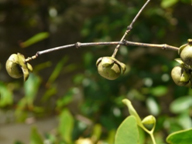Leaf epicuticular and pollen ultrastructural comparisons of Sonneratia apetala Buch.-Ham. and S. caseolaris (L.) Engler (Sonneratiaceaea)
Abstract
Sonneratia apetala and S. caseolaris are easily distinguishable by leaf epicuticular and pollen ultrastructure. S. apetala shows fine, distinct, intermingled rodlets of wax crystalloids on leaf surface with sunken stomata. In the contrary S. caseolaris shows wide, indistinct, rodlets of wax crystalloids with exposed stomata. Epicuticular structures enlighten an important adaptation toward transpiration control according to their area of occupancy in saline habitat. Pollens of the both species show the phenomenon of harmomegathy. Harmomegathic effect is pronounced in S. apetala.
References
Barthlott W. 1981. Epidermal and seed surface characters of plants: systematic application and some evolutionary aspects. Nord. J. Bot. 1: 345–355.
Barthlott W., Neinhuis C., Cutler D., Ditsch F., Meusel I., Theisen I., Wilhelmi H. 1998. Classification and terminology of plant epicuticular waxes. Bot. J. Linn. Soc. 126: 237–260.
Carpenter K.J. 2006. Specialized structures in the leaf epidermis of Basal Angiosperms: morphology, distribution, and homology. Am. J. Bot. 93: 665–681.
Graham S.A., Hall J., Sytsma K., Shi S. 2005. Phylogenetic analysis of the Lythraceae based on four gene regions and morphology. Int. J. Plant Sci. 166: 995–1017.
Graham S.A., Thorne R.F., Reveal J.L. 1998. Validation of subfamily names in Lythraceae. Taxon 47: 435–436.
Halbritter H., Hesse M. 2004. Principal modes of infoldings intricolp(or)ate Angiosperm pollen. Grana 43: 1–14.
Hesse M., Halbritter H., Zetter R., Weber M., Buchner R., Frosch-Radivo A., Ulrich S. 2009. Pollen terminology: An illustrated handbook. Springer Wien, New York.
Huang Y., Shi S. 2002. Phylogenetics of Lythraceae sensu lato: a preliminary analysis based on chloroplast rbcL gene, psaA-ycf3 spacer, and nuclear rDNA internal transcribed spacer (ITS) sequences. Int. J. Plant Sci. 163: 215–225.
Katifori E., Alben S., Cerda E., Nelson D.R., Dumais J. 2010. Foldable structures and the natural design of pollen grains. PNAS 107: 7635–7639.
Keating R.C. 1984. Leaf histology and its contribution to relationships in the Myrtales. Ann. Mo. Bot. Gard. 71: 801–823.
Knight T.G., Wallwork M.A.B., Sedgley M. 2004. Leaf epicuticular wax and cuticle ultrastructure of four Eucalyptus species and their hybrids. Int. J. Plant Sci. 165: 27–36.
Lane M.A. 1985. Features observed by electron microscopy as generic criteria. Taxon 34: 38–43.
Naskar K. 2004. Manual of Indian Mangroves: 93–97. Daya Publishing House, Delhi.
Naskar K. 2014. Histo-Physiological and biochemical studies of some salt tolerant plants of Indian Sundarbans. Ph.D. Thesis. University of Calcutta, Kolkata, India
Nedukha O.M. 2012. Ultrastucture of epidermal surface in floating and submerged leaves of Trapa natans L. Mod. Phytomorphol. 1: 77–80.
Patel V.C., Skvarla J.J., Raven P.H. 1984. Pollen characters in relation to the delimitation of Myrtales. Ann. Mo. Bot. Gard. 71: 858–969.
Riederer M. 2006. Introduction: biology of the plant cuticle. In: Riederer M., Müller C. (eds), Biology of the plant cuticle. Ann. Plant Rev. 23: 1–10.
Sauquet H., Cantrill D.J. 2007. Pollen diversity and evolution in Proteoideae (Proteales: Proteaceae). Syst. Bot. 32: 271–316.
Tomlinson P.B. 1986. The botany of mangroves. Cambridge University Press, Cambridge.
Volkova O.A., Severova E.E., Polevova S.V. 2013. Structural basis of harmomegathy: evidence from Boraginaceae pollen. Plant Syst. Evol. 299: 1769–1779.
Wang Y., Guignard G., Thévenard F., Dilcher D., Barale G., Mosbrugger V., Yang X., Mei S. 2005. Cuticular anatomy of Sphenobaiera huangii (Ginkgoales) from the Lower Jurassic of Hubei, China. Am. J. Bot. 92: 709–721.


This work is licensed under a Creative Commons Attribution-NonCommercial-NoDerivatives 4.0 International License.
The journal is licensed by Creative Commons under BY-NC-ND license. You are welcome and free to share (copy and redistribute the material in any medium or format) all the published materials. You may not use the material for commercial purposes. You must give appropriate credit to all published materials.
The journal allow the author(s) to hold the copyrights and to retain publishing rights without any restrictions. This is also indicated at the bottom of each article.





